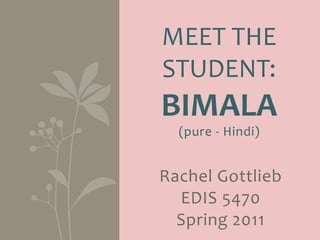
Meet the Student: Bimala
- 1. MEET THE STUDENT: BIMALA (pure -‐ H indi) Rachel Gottlieb EDIS 5 470 Spring 2 011
- 2. Who is Bimala? Personal Information: • 7 years old • 1st grade student • 2 years in the U.S. • from India, speaks Hindi at home • good friends with other ESL students
- 3. Who is Bimala? Educational Information: • WIDA level 2 (beginning) • has many characteristics of Stage III on Language Acquisition Chart • not literate in Hindi (L1) • attended same school for kindergarten • second year with same ESL teacher
- 4. Who is Bimala? Family Background: • small farming town, western Bengal • father – finished HS, some English • mother – 7th grade education, very LEP • paternal uncle –15 years in C-‐ville, translator/home & school contact • live in 2 BR apt close to school, no car • family active in school activities
- 5. Who is Bimala? Personal Interests: • Dora the Explorer • pink • horses and ponies • Disney princesses • dogs
- 6. Information about India Country and Culture ( Sources: State Dept., CIA World Factbook, Wikipedia) • Population: 2nd largest, 15% of world’s population (more than 1 billion) • Capital: New Delhi • Languages: Hindi (official), English • Geography: 3 geographic regions (Himalayan, Gangetic Plain, plateau) • Culture: Bollywood, dance, art, music
- 7. Information about India Education ( Sources: State Dept., CIA World Factbook, Wikipedia) • compulsory education K-‐10 • literacy level: 61% (U.S. 99%) • controlled by Union government, states • fundamental right protected in Constitution • rote learning, memorization • teacher absences
- 8. Information about India Hindi words • Hello/goodbye: Namaste • Hello/goodbye (colloquial): rām rām • Please: krpayā/kripaya • Thank you: dhanyawaad/dhanyavaad
- 9. How does Bimala learn? Characteristics Observed: • perfectionist • wants to be independent • likes one-‐on-‐one attention, but not help • usually quiet and reserved • sensitive – feelings hurt easily
- 10. How does Bimala learn? Reading Behaviors Observed • Looks up at teacher when comes across an unfamiliar word • doesn’t try to decode or sound out • Doesn’t recognize sight words • Doesn’t track words with finger • Doesn’t follow along when peers are reading aloud, turn page at same time
- 11. How does Bimala learn? Suggestions to Improve Learning • explicit vocabulary instruction • sight words, new vocabulary • pre-‐reading activities • text previews, picture walks • rhyming instruction • manipulatives, oral practice